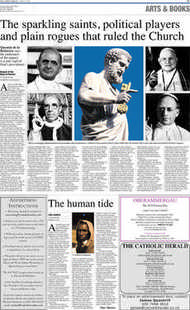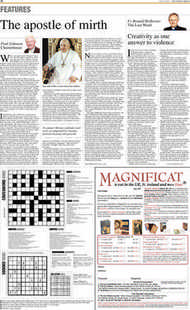Page 15, 15th May 2009
Page 15

Report an error
Noticed an error on this page?If you've noticed an error in this article please click here to report it.
Tags
Share
Related articles
Pope Benedict Blesses His Homeland After Sharing Jokes...
Spiritual Books Francis Phillips
Not Built In A Day
`i Hope For John Paul's Sainthood,' Says Pope
Pope Benedict Defends Role Of Wartime Pontiff
The sparkling saints, political players and plain rogues that ruled the Church
Quentin de la Bédoyère says the endurance of the papacy is a sure sign of God’s providence
BY ROGER COLLINS
Ahistory of the popes from St Peter to Benedict XVI in one, admittedly substantial, volume is an ambitious undertaking. That it is successful must be credited to Roger Collins’s scholarship and a wealth of research – particularly in the vast resources of the Vatican Library. It is always fairminded, and a useful resource for studying the span of the papacy.
Necessarily the book is concise since it covers 266 popes in some 500 pages. My only criticism of its structure is the thinness of the index. Too often I found myself looking up a topic elsewhere – to relate it to the pope concerned – before locating it in the book.
The continued existence of the papacy seems to me to be an act of God’s providence. We have a succession of men, some holy, some primarily political and some plain rogues. Yet the principle of unity has survived, often through chance and venality. And it has been this principle which has continued to hold the Church together, unlike its offshoots of the Protestant and Orthodox variety, which have been distinguished by their capacity for fragmentation.
It was this which enabled Macaulay to predict that the papacy might “still exist in undiminished vigour when some traveller from New Zealand shall, in the midst of a vast solitude, take his stand on a broken arch of London Bridge to sketch the ruins of St Paul’s”. I would rather have a corrupt pope than no pope at all.
But the principle of unity, based on the succession of authority from St Peter, was not established immediately. The Christian communities in Rome, even before the arrival of St Peter, were unorganised. The concept of bishop was at first unknown although there were undoubtedly elders who were set apart by their celebration of the Eucharist. And Irenaeus’s, late second century, confident list of episcopal succession from St Peter probably refers to the most prominent elders he could trace. Its primary purpose was to record a prevailing authority to stand against gnostic heresies.
And, even from this point, establishing papal authority throughout the Church was to be a long wrangle over the first millennium.
The battles often arose from rival sees which claimed apostolic foundation and at least equality with Rome. The whole issue was complicated by the central presence of the Roman Empire in Constantinople. Its power was considerable, and its exact relation to the current pope continually a matter of dispute. In fact, until about the 12th century, the pope ‘s ministry outside Italy was primarily confined to infrequent interventions, usually in responses to requests. In the West it was seen as the touchstone of orthodoxy, guaranteeing the validity of major councils.
But the East, while recognising that Rome had special honour as the See of Peter, was unwilling in practice to accept its autonomy. The current level of close jurisdiction is more a matter of historical accident than a logical development from the mandate given to Peter.
The disputes in the first millennium mainly concerned such matters as the hypostatic union. Did Christ have a substance like that of the Father, or one which was identical? The difference was that of a single Greek letter in the Creed. Did the Holy Spirit emerge from the Father and the Son (the famous filioque clause, key to the Orthodox schism).
All this may seem pedantic to us who are habituated to the outcome, yet this was the Church establishing over generations the real meaning of our salvation.
At the time, it often looked as if it was more a political power struggle – with the reigning pope as catspaw – than theological exploration. And the tendency of the popes to have rather short reigns, often as a result of malaria emanating from the toxic Pontine Marshes, contributed to the confusion. There were other disputes. Could those who had apostatised under persecution be received back into communion, and, if so, was it only to be on their deathbeds? And the heresy of Pelagianism – which is my favourite because its founder was British – played its part. Could a man pull himself up by his own bootstraps, or did he require grace before he could even turn his will towards God?
Pelagianism provides a good example of how things were. St Augustine attacked it and Innocent III partially condemned it. Zozimus, his successor, fearful of Pelagius’s popularity among the senatorial aristocracy, reversed this. But Augustine used his political influence (no doubt there would have been leaked emails in another age). Motivated by a riot in the city, for which the Pelagians were conveniently blamed, the Empire banished them, and Zosimus found it prudent to change his mind and condemn the heresy.
Enough has been written about the Crusades, the Inquisition and indulgences for me not to mention these further.
Although it may be worth noting that Luther’s strictures, allegedly fixed to the church door at Wittenberg were, for the most part, well founded.
The Reformation, whether Henrician or Protestant, found its motivation in power, and only its matter in doctrine.
The Council of Trent provided stability, but strait-jacketed the Church right up to the effects of the condemnation of the Modernist movement by Pius X in the 20th century. And so it inhibited the Church’s dialogue with society, although it had much to contribute. And the direction of Vatican II in the longer term is as yet unknown.
Collins brings us up to date with the modern papacy: the over-cautious Pius XII, the robust openness of John XXIII, the conscientious and troubled Paul VI, the embattled firmness of John Paul II, and the scholarly Benedict XVI who finds it hard to connect with less well furnished minds, all provide enough variety in our own time to display the ever-changing relationship between personality and circumstances which has been the nature of the papacy over the last 2,000 years. And will be, over the next.
blog comments powered by Disqus





















